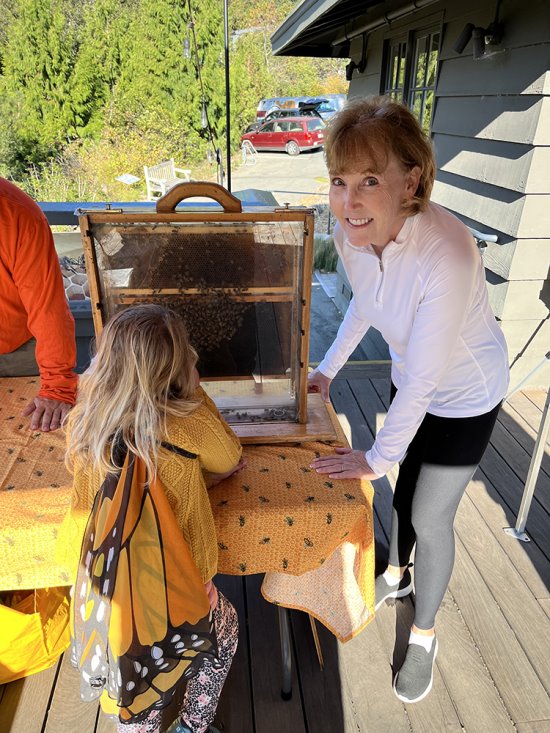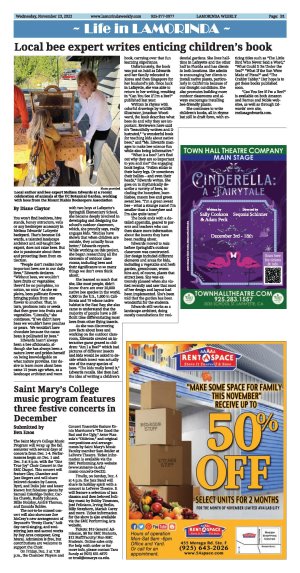| | Published November 23rd, 2022
| Local bee expert writes enticing children's book
| | | By Diane Claytor |  | | Local author and bee expert Melissa Edwards at a recent celebration of animals at the UC Botanical Garden, working with bees from the Mount Diablo Beekeepers Association Photo provided |
You won't find beehives, hive stands, honey extractors, veils or any beekeeper accessory in Melissa Edwards' Lafayette backyard. That's because Edwards, a talented landscape architect and self-taught bee expert, does not raise bees. But she is passionate about them and protecting them from extinction.
 "People don't realize how important bees are in our daily lives," Edwards declares. "Without bees, we wouldn't have fruits or vegetables; there'd be no pumpkins, no cotton, no nuts." As she explains, bees pollinate flowers, bringing pollen from one flower to another. That, in turn, produces nuts or seeds that then grow into fruits and vegetables. "Literally," she continues, "if we didn't have bees we wouldn't have peaches or pears. We wouldn't have chocolate because the cacao bean is pollinated by bees."
"People don't realize how important bees are in our daily lives," Edwards declares. "Without bees, we wouldn't have fruits or vegetables; there'd be no pumpkins, no cotton, no nuts." As she explains, bees pollinate flowers, bringing pollen from one flower to another. That, in turn, produces nuts or seeds that then grow into fruits and vegetables. "Literally," she continues, "if we didn't have bees we wouldn't have peaches or pears. We wouldn't have chocolate because the cacao bean is pollinated by bees."
 Edwards hasn't always been a bee aficionado, although she has always been a nature lover and prides herself on being knowledgable on what nature provides. Her desire to learn more about bees came 15 years ago when, as a landscape architect and mom with two boys at Lafayette's Springhill Elementary School, she became deeply involved in developing and designing the school's outdoor classroom, which, she proudly says, really engages kids. "Studies have shown that when children are outside, they actually focus better," Edwards reports. While working on this project, she began researching all the elements of outdoor classrooms, including bees and their significance to so many things we don't even think about.
Edwards hasn't always been a bee aficionado, although she has always been a nature lover and prides herself on being knowledgable on what nature provides. Her desire to learn more about bees came 15 years ago when, as a landscape architect and mom with two boys at Lafayette's Springhill Elementary School, she became deeply involved in developing and designing the school's outdoor classroom, which, she proudly says, really engages kids. "Studies have shown that when children are outside, they actually focus better," Edwards reports. While working on this project, she began researching all the elements of outdoor classrooms, including bees and their significance to so many things we don't even think about.
 She learned so much that she, like most people, didn't know: there are over 20,000 native bee species in the world, 4,000 in the U.S., 1,600 in California and 79 whose native habitat is the East Bay; she also came to understand that the majority of people have a difficult time differentiating most bees from other flying insects.
She learned so much that she, like most people, didn't know: there are over 20,000 native bee species in the world, 4,000 in the U.S., 1,600 in California and 79 whose native habitat is the East Bay; she also came to understand that the majority of people have a difficult time differentiating most bees from other flying insects.
 As she was discovering new facts about bees and working on the outdoor classroom, Edwards created an interactive game geared to children: "Am I a Bee?" which had pictures of different insects and kids would be asked to decide which insect was actually one of the many species of bees. "The kids really loved it," Edwards recalls. She then had the idea of writing a children's book, carrying over that fun learning experience.
As she was discovering new facts about bees and working on the outdoor classroom, Edwards created an interactive game geared to children: "Am I a Bee?" which had pictures of different insects and kids would be asked to decide which insect was actually one of the many species of bees. "The kids really loved it," Edwards recalls. She then had the idea of writing a children's book, carrying over that fun learning experience.
 Unfortunately, the book was put on hold as Edwards and her family relocated to Korea and then Singapore for her husband's job. Once back in Lafayette, she was able to return to her writing, resulting in "Can You See If I'm a Bee?" published last year.
Unfortunately, the book was put on hold as Edwards and her family relocated to Korea and then Singapore for her husband's job. Once back in Lafayette, she was able to return to her writing, resulting in "Can You See If I'm a Bee?" published last year.
 Written in rhyme with colorful drawings by wildlife illustrator, Jonathan Woodward, the book describes what bees do and why they are important. Reviewers have said it's "beautifully written and illustrated," "a wonderful book for teaching kids about native bees," and "Ms. Edwards manages to make bee science fun while also being informative."
Written in rhyme with colorful drawings by wildlife illustrator, Jonathan Woodward, the book describes what bees do and why they are important. Reviewers have said it's "beautifully written and illustrated," "a wonderful book for teaching kids about native bees," and "Ms. Edwards manages to make bee science fun while also being informative."
 "What is a bee? Let's find out why they are so important to you and me!" the engaging book begins. "Pollen sticks to their hairy legs. Or sometimes their bellies - and even their heads," Edwards writes. She goes on to rhythmically describe a variety of bees, including the honeybee, bumblebee, mason bee and green sweat bee. "I'm a green sweat bee - what a strange name! I'm smaller than a honeybee and I'm also quite tame."
"What is a bee? Let's find out why they are so important to you and me!" the engaging book begins. "Pollen sticks to their hairy legs. Or sometimes their bellies - and even their heads," Edwards writes. She goes on to rhythmically describe a variety of bees, including the honeybee, bumblebee, mason bee and green sweat bee. "I'm a green sweat bee - what a strange name! I'm smaller than a honeybee and I'm also quite tame."
 The book ends with a detailed appendix, geared to parents and teachers who can then share more information about the insects they have been reading about.
The book ends with a detailed appendix, geared to parents and teachers who can then share more information about the insects they have been reading about.
 Edwards moved to Asia before Springhill's outdoor classroom was constructed. Her design included different elements and areas for kids, including a vegetable and herb garden, greenhouse, worm bins and, of course, plants that attract bees. She was extremely pleased when she visited recently and saw that most of her design and layout had been implemented. She's been told that the garden has been wonderful for the students.
Edwards moved to Asia before Springhill's outdoor classroom was constructed. Her design included different elements and areas for kids, including a vegetable and herb garden, greenhouse, worm bins and, of course, plants that attract bees. She was extremely pleased when she visited recently and saw that most of her design and layout had been implemented. She's been told that the garden has been wonderful for the students.
 Edwards still works as a landscape architect, doing mostly consultations for residential gardens. She lives half-time in Lafayette and the other half in Florida and has clients in both locations. She admits to encouraging her clients to install native plants, particularly in California because of our drought conditions. She also promotes building more outdoor classrooms and always encourages installing bee-friendly plants.
Edwards still works as a landscape architect, doing mostly consultations for residential gardens. She lives half-time in Lafayette and the other half in Florida and has clients in both locations. She admits to encouraging her clients to install native plants, particularly in California because of our drought conditions. She also promotes building more outdoor classrooms and always encourages installing bee-friendly plants.
 She continues to write children's books, all in rhyme but still in draft form, with enticing titles such as "The Little Bird Who Never Said a Word," "What Could It Be Under the Sea?" "What If the Sun Were Made of Pizza?" and "The Crabby Tabby." Her hope is to get these books published soon.
She continues to write children's books, all in rhyme but still in draft form, with enticing titles such as "The Little Bird Who Never Said a Word," "What Could It Be Under the Sea?" "What If the Sun Were Made of Pizza?" and "The Crabby Tabby." Her hope is to get these books published soon.
 "Can You See If I'm a Bee?" is available on both Amazon and Barnes and Noble websites, as well as through Edwards' own site, www.melissagedwards.com.
"Can You See If I'm a Bee?" is available on both Amazon and Barnes and Noble websites, as well as through Edwards' own site, www.melissagedwards.com. |
| | | | | | | | | | | | |



